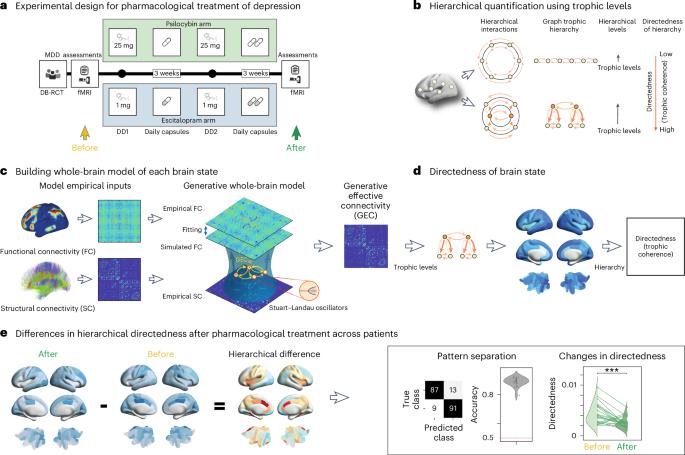Different hierarchical reconfigurations in the brain by psilocybin and escitalopram for depression
引用次数: 0
Abstract
Effective interventions for neuropsychiatric disorders may work by rebalancing the brain’s functional hierarchical organization. Here we directly investigated the effects of two different serotonergic pharmacological interventions on functional brain hierarchy in major depressive disorder in a two-arm double-blind phase II randomized controlled trial comparing psilocybin therapy (22 patients) with escitalopram (20 patients). Patients with major depressive disorder received either 2 × 25 mg of oral psilocybin, three weeks apart, plus six weeks of daily placebo (‘psilocybin arm’) or 2 × 1 mg of oral psilocybin, three weeks apart, plus six weeks of daily escitalopram (10–20 mg; ‘escitalopram arm’). Resting-state functional magnetic resonance imaging scans were acquired at baseline and three weeks after the second psilocybin dose ( NCT03429075 ). The brain mechanisms were captured by generative effective connectivity, estimated from whole-brain modeling of resting state for each session and patient. Hierarchy was determined for each of these sessions using measures of directedness and trophic levels on the effective connectivity, which captures cycle structure, stability and percolation. The results showed that the two pharmacological interventions created significantly different hierarchical reconfigurations of whole-brain dynamics with differential, opposite statistical effect responses. Furthermore, the use of machine learning revealed significant differential reorganization of brain hierarchy before and after the two treatments. Machine learning was also able to predict treatment response with an accuracy of 0.85 ± 0.04. Overall, the results demonstrate that psilocybin and escitalopram work in different ways for rebalancing brain dynamics in depression. This suggests the hypothesis that neuropsychiatric disorders could be closely linked to the breakdown in regions orchestrating brain dynamics from the top of the hierarchy. Psilocybin and escitalopram create significantly different reconfigurations in the global functional hierarchy of brain dynamics with opposite statistical effect responses in people with major depressive disorder.

西洛西宾和艾司西酞普兰治疗抑郁症在大脑中的不同层次重构
对神经精神障碍的有效干预可能是通过重新平衡大脑的功能层次结构来实现的。在这项双臂双盲 II 期随机对照试验中,我们直接研究了两种不同的血清素能药物干预对重度抑郁障碍患者大脑功能层次结构的影响,并将西洛滨疗法(22 名患者)与艾司西酞普兰疗法(20 名患者)进行了比较。重度抑郁症患者接受 2 × 25 毫克口服西洛赛宾,间隔三周,外加六周每日服用安慰剂("西洛赛宾治疗组"),或 2 × 1 毫克口服西洛赛宾,间隔三周,外加六周每日服用艾司西酞普兰(10-20 毫克;"艾司西酞普兰治疗组")。静息态功能磁共振成像扫描在基线和第二次服用迷幻药三周后进行(NCT03429075)。大脑机制是通过生成有效连通性来捕捉的,而生成有效连通性是通过对每个疗程和患者的静息状态进行全脑建模来估算的。利用有效连通性上的定向性和营养水平的测量方法确定了每个疗程的层次结构,从而捕捉到循环结构、稳定性和渗流。结果表明,两种药物干预对全脑动力学产生了明显不同的分层重构,并产生了不同的、相反的统计效应反应。此外,机器学习的使用还揭示了两种治疗前后大脑层次结构重组的显著差异。机器学习还能预测治疗反应,准确率为 0.85 ± 0.04。总之,研究结果表明,西洛滨和艾司西酞普兰以不同的方式重新平衡抑郁症患者的大脑动态。这就提出了一个假设,即神经精神疾病可能与从层次结构的顶层开始协调大脑动力的区域出现故障密切相关。在重度抑郁症患者中,迷幻药和艾司西酞普兰对大脑动力的整体功能层次结构产生了明显不同的重新配置,其统计效应反应也截然相反。
本文章由计算机程序翻译,如有差异,请以英文原文为准。
求助全文
约1分钟内获得全文
求助全文

 求助内容:
求助内容: 应助结果提醒方式:
应助结果提醒方式:


